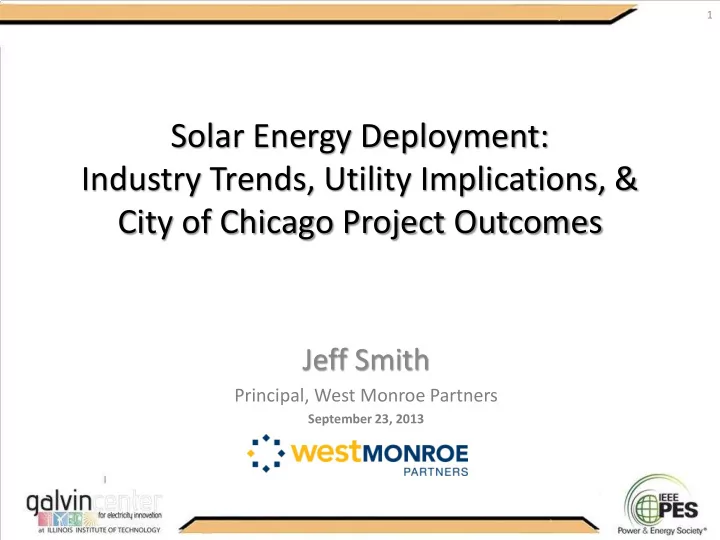

1 Solar Energy Deployment: Industry Trends, Utility Implications, & City of Chicago Project Outcomes Jeff Smith Principal, West Monroe Partners September 23, 2013
2 Presentation Outline • Recent solar industry trends • Electric Utility impacts of increasing distributed solar deployment • Outcomes of Chicago Solar Project
3 Over the past decade, the #1 driver of distributed generation (DG) growth has been solar PV installed capacity… Cumulative U.S. Solar PV Installations (7,300 MWdc) 20% Residendial 40% Non-Residential Utility 40% 60% of US solar PV capacity (or about 4 GW) is feeding into distribution grid systems Source: http://www.irecusa.org/wp-content/uploads/2013/07/Solar-Report-Final-July-2013-1.pdf 3
4 … which translate to a large volume of Interconnection and Net Metering applications. • Over 90,000 unique distributed solar PV installations occurred in 2012 (compared to ~500 centralized installations greater than 1 megawatt capacity). • NOTE: The vast majority of solar is being installed in only a handful of states Translation: Every MW of solar PV capacity translates to 300 – 500 utility applications. Source: http://www.irecusa.org/wp-content/uploads/2013/07/Solar-Report-Final-July-2013-1.pdf 4
5 This has created a challenge for utilities: traditional Power Supply and Demand balancing bodies do not necessarily account for the load impacts of DG Demand Central Supply Transmission Operator Conventional Power Generation Distribution System Operators Balancing Authority Utility-Scale Intermittent Resources Consolidators Forecasts customer load and secures power Delivers and sells power into the transmission purchases to meet anticipated demand grid DG Supply (masks load) Grid operators are adapting to the growth of DG systems 5
6 This challenge can be solved through DG resource management, composed of: enrollment, asset management, and operations/forecasting To System Owners… To the Electric Utility… Speed-to-market through Inter-departmental approvals; city and utility requirements technical screening; meter exchange; bill switching Enrollment Archiving applications, Standardizing legacy datasets generating RECs, and new systems/information into Asset registering the system, a ‘single source of truth’ across Management inventorying the IT/OT systems equipment components Informing utility distribution Operations/ engineering and capacity Ensuring system performance Forecasting meets expectations; proper planning on DG information, billing/maintenance; tampering estimating impacts on detection customer load 6
7 Utilities are one of two administrative bodies authorized to approve and inspect DG resources prior to commercial operations Solar Deployment from Initiation to Operations: Secure Site Feasibility Project Administrative Procurement/ Field Commercial Funding/ Analysis Engineering Approvals Installation Inspections Operations Contractors • Electrical • Zoning Approval • Capacity Planning • Building Permit Inspection • Network Operations • Electrical Permit • Load Forecasting • Meter set / Witness testing • Interconnection/Net Metering Requests Color-coding: Authority Having Jurisdiction (e.g., Cities) Electric Distribution Company 7
8 Standard processes and limited staff resources have utilities turning to technology solutions to ease variable application volumes and manage staffing resources Process Constraints • Nearly all states are easing the approval process for DG resources, including granting non- discriminatory grid access of DG resources through standard interconnection rules – The Federal Energy Regulatory Commission (FERC) encouraged this trend with the 2006 Small Generator Interconnection Procedures – In January 2013, FERC published a Notice of Proposed Rulemaking (NOPR) that intends to further reduce the time and cost to process small generator interconnection requests in a pro forma manner (citing solar PV growth as a driver) Finite Staff Resources State Incentive cycles and seasonality cause pressure on utility interconnection staff to meet regulatory timeframes FERC NOPR pre-application reports will add an additional responsibility in staff resources Technology Opportunities Online application processing allows improved customer and utility staff experience Main benefits are associated with improved accuracy, automated workflow management, and milestone tracking and transparency The Interstate Renewable Energy Council (IREC)’s “ 2013 Model Interconnection Procedures ” report lists online application submission as a recommended best practice (NYPSC has adopted this guideline for systems <25 kilowatts) 8
9 The Chicago Solar Market Transformation Team streamlined the DG enrollment process Chicago’s Solar Market Transformation Team (“Solar Team”): – Sponsored through the Mayor’s office, worked with multiple City, industry, utility, non -profit, and institutional stakeholders – Work completed in early 2013 – Origination: The City of Chicago, along with 21 other teams, received Phase 1 funding from the DOE to induce market growth of residential and commercial-scale rooftop PV systems Solar Improvement Areas: Permitting: Instructions manual/workbook; same day review for small projects, accelerated review of large Solar permitting guidelines projects Self-certification matrix Now includes rooftop solar photovoltaic systems ASCE7-05 and SEAOC PV2 Standards Are Allowed For the Review Of Rooftop Solar Photovoltaic Administrative Relief from Chicago Building Code Panel Wind Loading Zoning: solar zoning policy Now includes solar PV waiver from green roof requirements, based on 1:4 area coverage factor Sustainable Development Matrix Interconnection: Interconnection and net metering Application Tool provides online submission portal for DOE interconnection best practices webinar (slides 23 interconnection/net metering applications (Levels 1 - 4), with error checking, electronic payment, - 32) and applicant tracking. Education: One-stop resource for all solar-related inquiries from contractors, design professionals, and City of Chicago’s Solar webpage residents
10 Questions? Jeff Smith Email: jsmith@westmonroepartners.com Business Phone: 312.846.9949
Recommend
More recommend